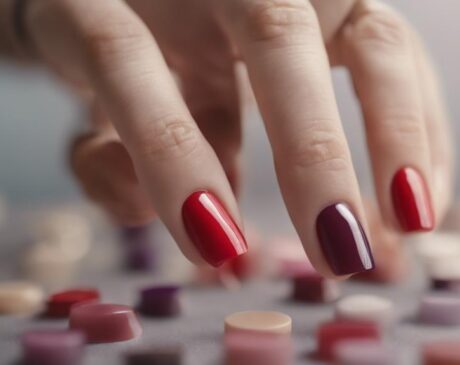Which Type of UV Light Is the Best for the Curing of Gel Nail Polish?
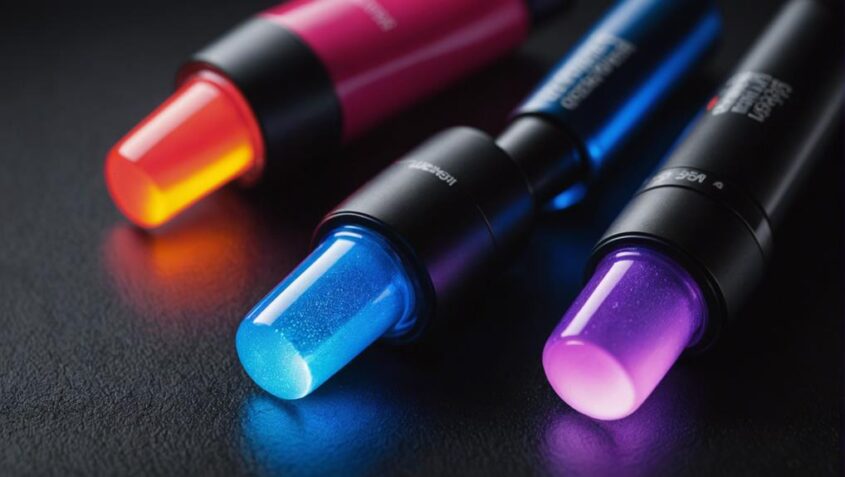
To achieve optimal curing of gel nail polish, LED lamps are favored for their efficient and fast curing capabilities. LED lamps emit narrower wavelengths, ensuring quicker drying times and are energy-efficient with a longer lifespan. Understanding UV lamp wavelengths, which typically range between 365nm to 405nm, is crucial for matching the gel polish formulation. Factors such as power output, durability, and precise wavelength control impact the quality of the manicure. For efficient gel curing, applying thin layers of gel polish, proper nail preparation, and investing in quality equipment are key. Consider these aspects to enhance your nail beautification process.
Key Takeaways
- LED lamps offer fast curing times with energy efficiency.
- UV lamps provide a broader spectrum for thorough curing.
- Optimal UV wavelength ranges from 365nm to 405nm.
- Consider power output for a professional finish.
- Quality gel polish and matching UV light ensure flawless results.
Different Types of UV Lights
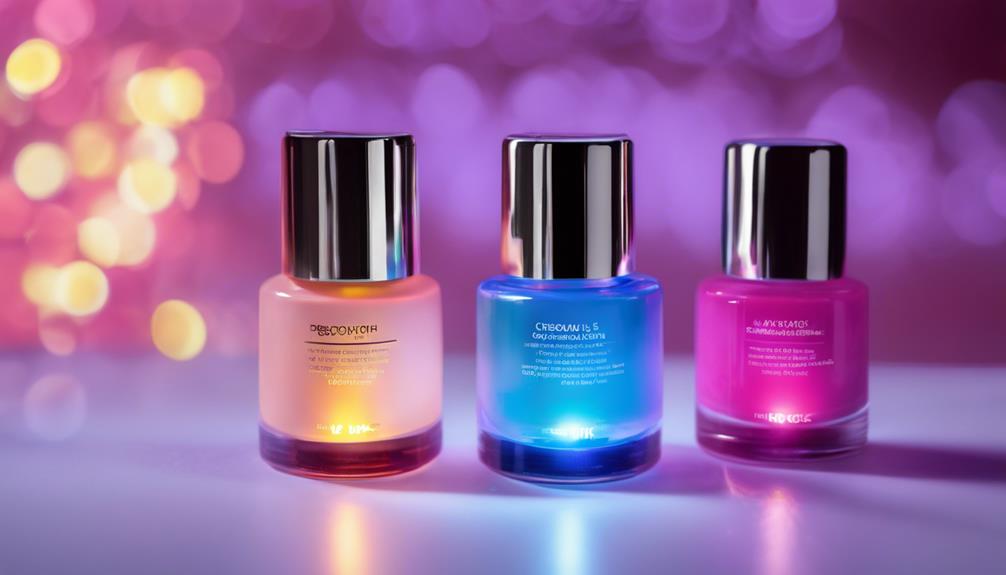
When considering gel nail polish, understanding the various types of UV lights available is essential for achieving a professional and lasting manicure. The two primary types of UV lights used for curing gel nail polish are UV lamps and LED lamps. UV lamps emit a broader spectrum of UV light, which can cure a wider range of gel polishes but requires longer curing times. On the other hand, LED lamps produce narrower wavelengths of light, targeting specific photoinitiators in gel polish for faster curing times. LED lamps are also more energy-efficient and have a longer lifespan compared to UV lamps.
Within the realm of UV lamps, there are further distinctions between low-wattage UV lamps and higher-wattage UV lamps. Low-wattage UV lamps are suitable for curing thin layers of gel polish and are more gentle on the nails, while higher-wattage UV lamps are faster and more powerful, making them ideal for curing thicker layers of gel polish efficiently. Understanding the differences between these UV lights is crucial for nail technicians and enthusiasts seeking optimal results in gel nail polish applications.
Pros and Cons of LED Lamps
LED lamps offer distinct advantages and disadvantages in the realm of gel nail polish applications. On the positive side, LED lamps are known for their speed and efficiency in curing gel polish. They are often faster than traditional UV lamps, reducing the curing time significantly. Additionally, LED lamps are more energy-efficient and have a longer lifespan compared to UV lamps. Their compact size and durability make them a popular choice for both professional salons and home users. However, there are some drawbacks to consider. LED lamps can be more expensive upfront, although the long-term cost savings due to energy efficiency can offset this. Some LED lamps may have limited compatibility with certain gel polish brands, so it's essential to check compatibility before purchasing.
| Pros | Cons |
|---|---|
| Faster curing time | Higher initial cost |
| Energy-efficient | Limited compatibility |
| Longer lifespan | |
| Compact size | |
| Durable |
Understanding UV Lamp Wavelengths
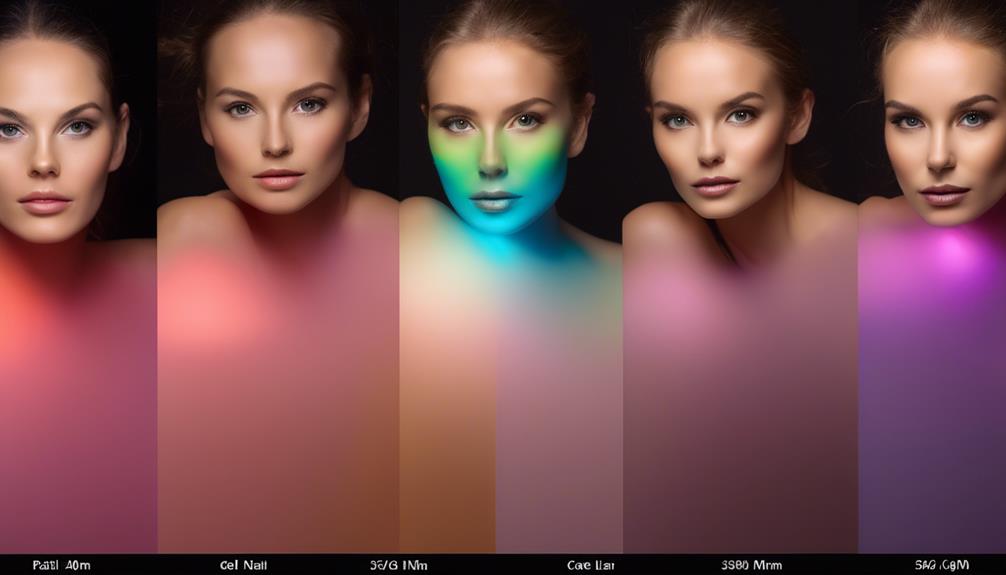
Exploring the significance of UV lamp wavelengths is crucial for understanding their impact on the curing process of gel nail polish. UV lamp wavelengths play a vital role in determining the efficiency and effectiveness of curing gel nail polish. Here are five key points to consider regarding UV lamp wavelengths:
- Wavelength Range: Different UV lamps emit light within specific wavelength ranges, such as UVA, UVB, or UVC, each affecting the gel curing process differently.
- Optimal Wavelength: The optimal wavelength for curing gel nail polish is typically around 365nm to 405nm, ensuring thorough curing without causing harm to the skin.
- Penetration Depth: Understanding how different wavelengths penetrate the layers of gel polish helps in achieving uniform curing and preventing uncured layers.
- Curing Time: The wavelength of the UV light can impact the curing time, with shorter wavelengths generally curing faster but requiring precise control to avoid overexposure.
- Compatibility: Ensure that the UV lamp wavelength is suitable for the specific gel polish formulation being used to achieve the best curing results.
Factors to Consider When Choosing
Factors that influence the selection of an appropriate UV light for gel nail polish curing include wavelength compatibility, power output, and durability. Wavelength compatibility is crucial as different gel polishes require specific wavelengths to cure effectively. Ensuring that the UV light emits the correct wavelength will result in a flawless and long-lasting manicure. Power output is another vital factor to consider. Higher power output lamps can cure gel polish faster and more efficiently, saving time and providing a professional finish. Additionally, durability plays a significant role in the longevity of the UV light. Opting for a durable lamp ensures that it will withstand frequent use without compromising its curing capabilities. By carefully considering these factors, one can select a UV light that meets the requirements for efficient gel nail curing, ultimately enhancing the overall nail beautification process.
Tips for Efficient Gel Nail Curing
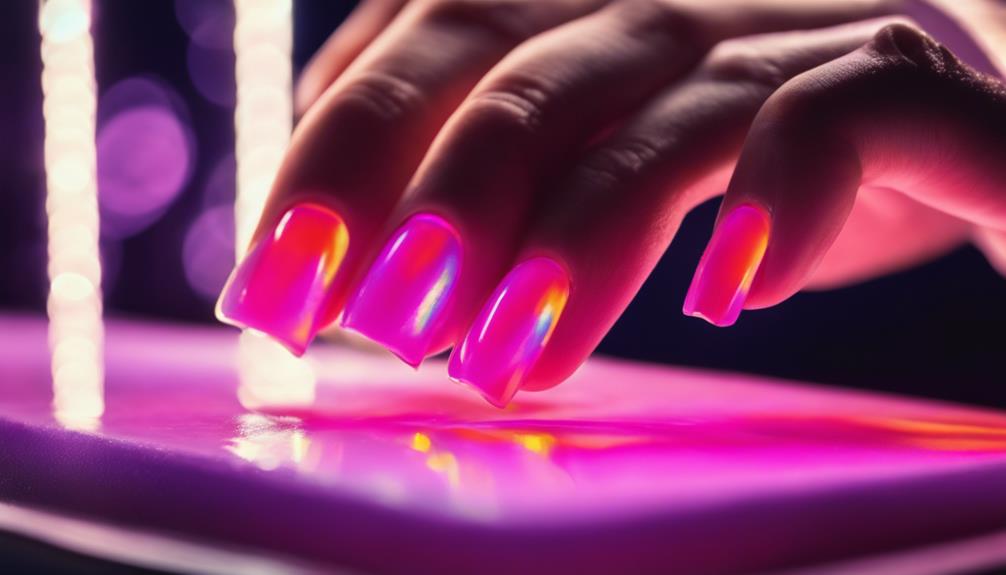
To enhance the efficiency of gel nail curing, it is essential to optimize the application process and utilize proper techniques. Here are five innovative tips to ensure a more effective gel nail curing experience:
- Thin Layers: Apply gel polish in thin layers to ensure even curing and prevent overheating.
- Proper Prep: Thoroughly prep the nails by buffing, shaping, and cleaning to promote better adhesion and curing.
- Avoid Skin Contact: Keep the gel polish off the skin surrounding the nails to prevent lifting and ensure proper curing.
- Use Quality Products: Invest in high-quality gel polish and curing equipment for better results and longevity.
- Cure Fully: Allow each layer of gel polish to cure fully under the UV light to prevent wrinkling or smudging.
Frequently Asked Questions
Can Any Regular Light Source Cure Gel Nail Polish?
Regular light sources typically lack the specific wavelength required to effectively cure gel nail polish. Specialized UV lights are recommended for optimal results. These lights emit the necessary UV rays to activate the gel's curing process, ensuring a durable and long-lasting finish.
Are All UV Nail Lamps Safe for Home Use?
UV nail lamps have revolutionized home nail care, offering quick and efficient gel polish curing. While most UV nail lamps are safe for home use, it's crucial to ensure they emit the right wavelength for proper curing.
How Often Should UV Bulbs Be Replaced?
UV bulbs in nail lamps should be replaced every 6 months to maintain optimal curing performance. Regularly changing bulbs ensures consistent results and prevents potential harm from using degraded bulbs. Consult manufacturer guidelines for specific recommendations.
Do UV Nail Lamps Emit Harmful Radiation?
Recent studies reveal that UV nail lamps emit low levels of UVA radiation, comparable to natural sunlight exposure. While risks exist, proper usage and protective measures can mitigate potential harm. Consult with professionals for safe practices.
Can Gel Nail Polish Be Cured Without a UV Lamp?
Gel nail polish typically requires UV or LED light for curing due to their chemical composition. However, some newer formulations claim to cure without a UV lamp. While results vary, traditional UV or LED lamps remain the most reliable method.

